Iron Deficiency Anemia Treatment Market Size and Trends
Global iron deficiency anemia treatment market is estimated to be valued at US$ 13.17 Bn in 2025 and is expected to reach US$ 23.78 Bn by 2032, exhibiting a compound annual growth rate (CAGR) of 8.8% from 2025 to 2032.
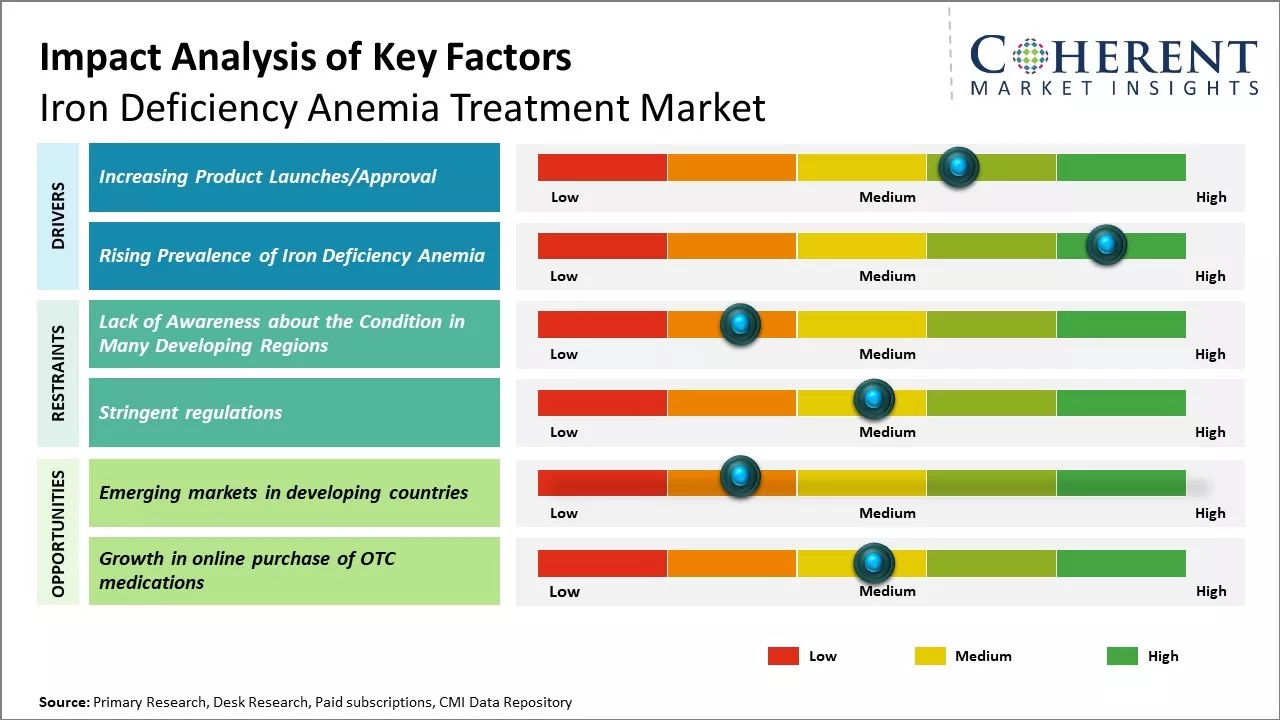
Discover market dynamics shaping the industry: Download Free Sample
Global iron deficiency anemia treatment market has significant growth potential over the forecast period due to high prevalence of iron deficiency anemia worldwide, especially among pregnant women and children under five years of age in developing regions. The market growth will be driven by increasing healthcare expenditures and rising awareness about iron deficiency anemia screening and management. However, the market may face restraints from the availability of alternative medical therapies and dietary supplements. North America and Europe will continue to dominate the iron deficiency anemia treatment market, owing to rising incidence of IDA among elderly populations. However, Asia Pacific is expected to witness the fastest growth owing to high population density, growing geriatric demographic, and rising health consciousness. The market will witness numerous opportunities arising from new product launches, increasing healthcare access in emerging countries, and the growth of medical tourism in Asia.
Increasing Product Launches/Approval
Increasing adoption of inorganic growth strategies such as product launches approvals is expected to drive the market growth over the forecast period. For instance, in January 2021, Pharmascience Inc., a pharmaceutical company, announced the launch of pms-IRON SUCROSE, a generic drug with demonstrated bioequivalence to the brand name VENOFER for the treatment of iron deficiency anemia in patients with chronic kidney disease.
Market Concentration and Competitive Landscape
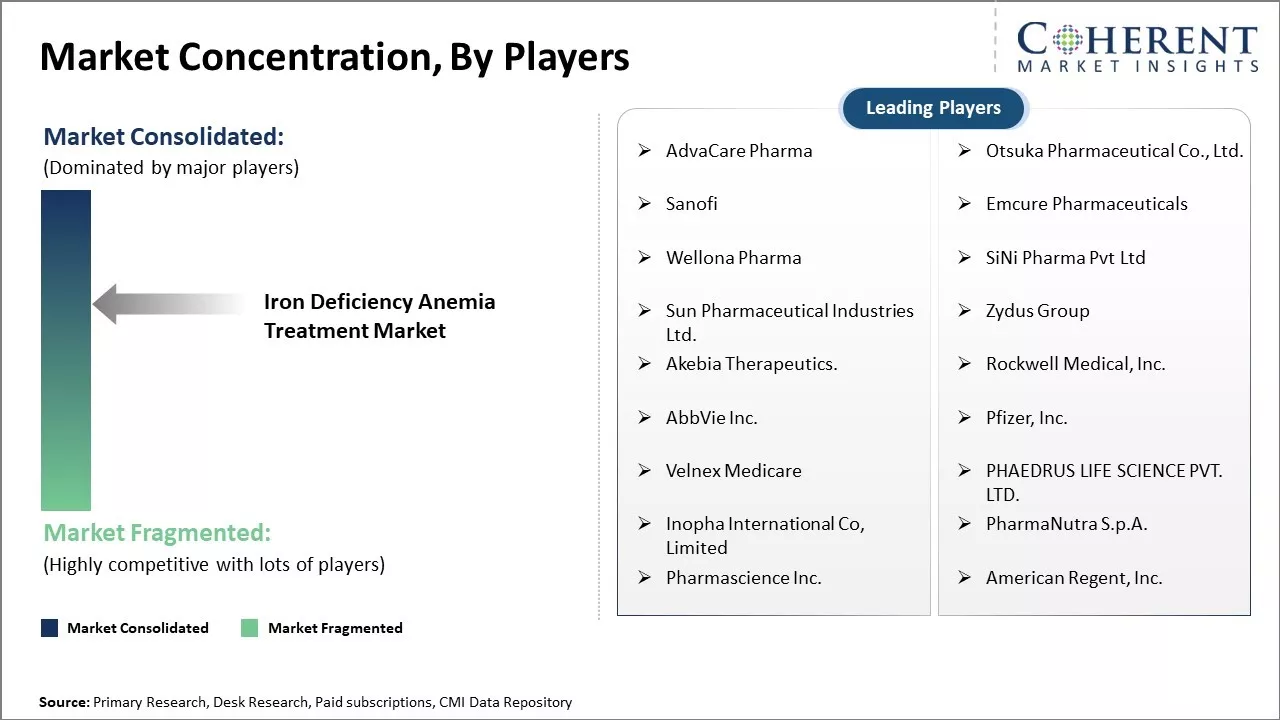
Get actionable strategies to beat competition: Download Free Sample
Rising Prevalence of Iron Deficiency AnemiaIron deficiency anemia affects millions of people globally every year. The condition is more prevalent among young children and women of childbearing age. Pregnancy associated blood loss along with poor nutrition rich in iron are major reasons for their increased vulnerability. Lack of adequate iron in diet can negatively impact cognitive development in children and energy levels in adults. Addressing this widespread public health concern through effective treatment options is crucial. With growing malnutrition and dietary changes in developing nations, more individuals are at the risk of falling short on iron intake. Even in developed countries, factors such as excessive blood loss during menstruation, blood donations or gastrointestinal disorders can potentially lead to iron deficiency anemia in otherwise healthy individuals. This rising disease prevalence indicates a clear clinical need for therapies that aid in restoring iron balance and hemoglobin levels in the body. Therefore, increased awareness and focus on diagnosing as well as treating iron deficiency anemia through innovation in products is anticipated to drive significant market growth.
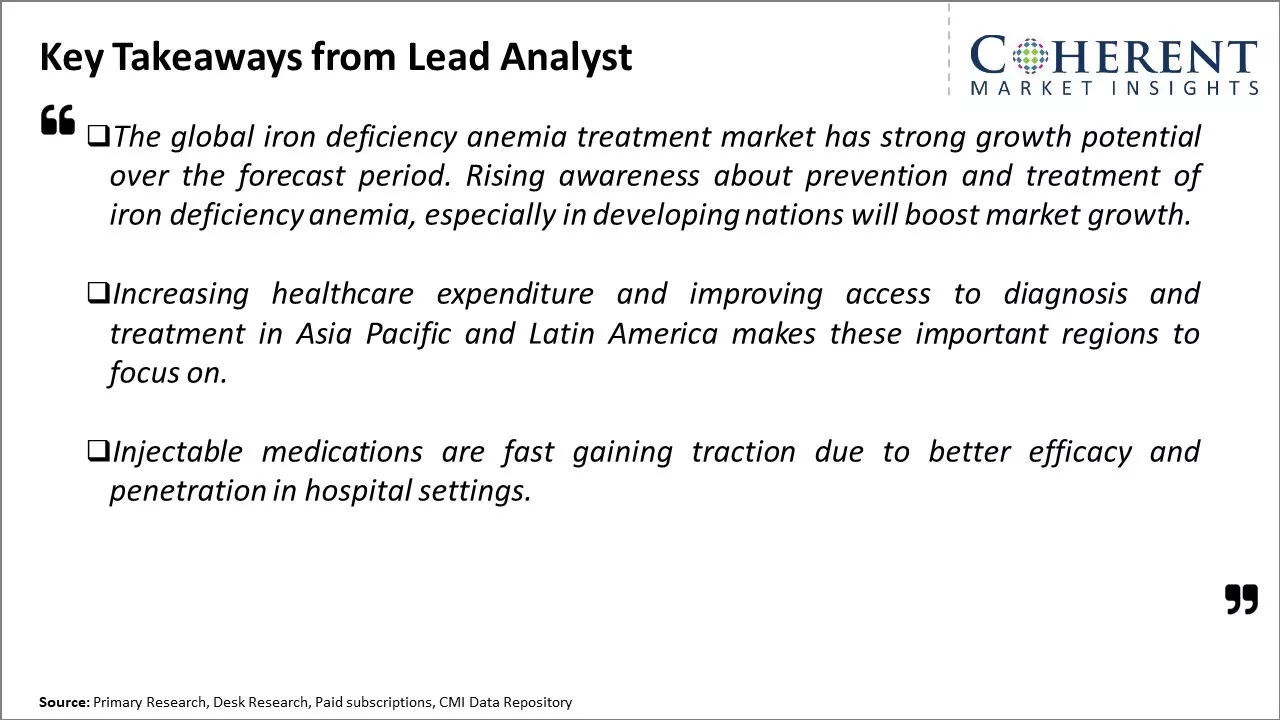
To learn more about this report, Download Free Sample
Market Challenges – Lack of Awareness about the Condition in Many Developing Regions
One of the key challenges faced by iron deficiency anemia treatment market is lack of awareness about the condition in many developing regions. This leads to underdiagnosis of the condition. The treatment options available are often prescribed incorrectly or consumed inconsistently due to poor compliance. The side effects of available treatments such as constipation and black stools discourage regular intake. Poverty is also a major roadblock for large segments to afford prescribed medicinal iron supplements or balanced diets essential to deal with this widespread deficiency.
Market Opportunities – Untapped emerging markets
Untapped emerging markets can provide tremendous opportunities for growth of global iron deficiency anemia treatment market. Regions like Asia Pacific, Latin America, Middle East and Africa offer a large patient pool suffering from iron deficiency anemia due to various social, economic and public health challenges. According to WHO, about 1.9 billion people are affected globally by anemia, majority of whom have iron deficiency anemia due to deficient intake of iron-rich foods and chronic blood loss. Countries with developing economies have a higher burden due to inadequate dietary intake and poor nutritional absorption. These emerging regions are expected to witness higher healthcare investments and reforms in coming years to strengthen their medical infrastructure and enhance access to diagnostic testing and treatment. Various programs by governments and non-profits are working to improve awareness regarding iron deficiency anemia, its symptoms and importance of proper treatment.
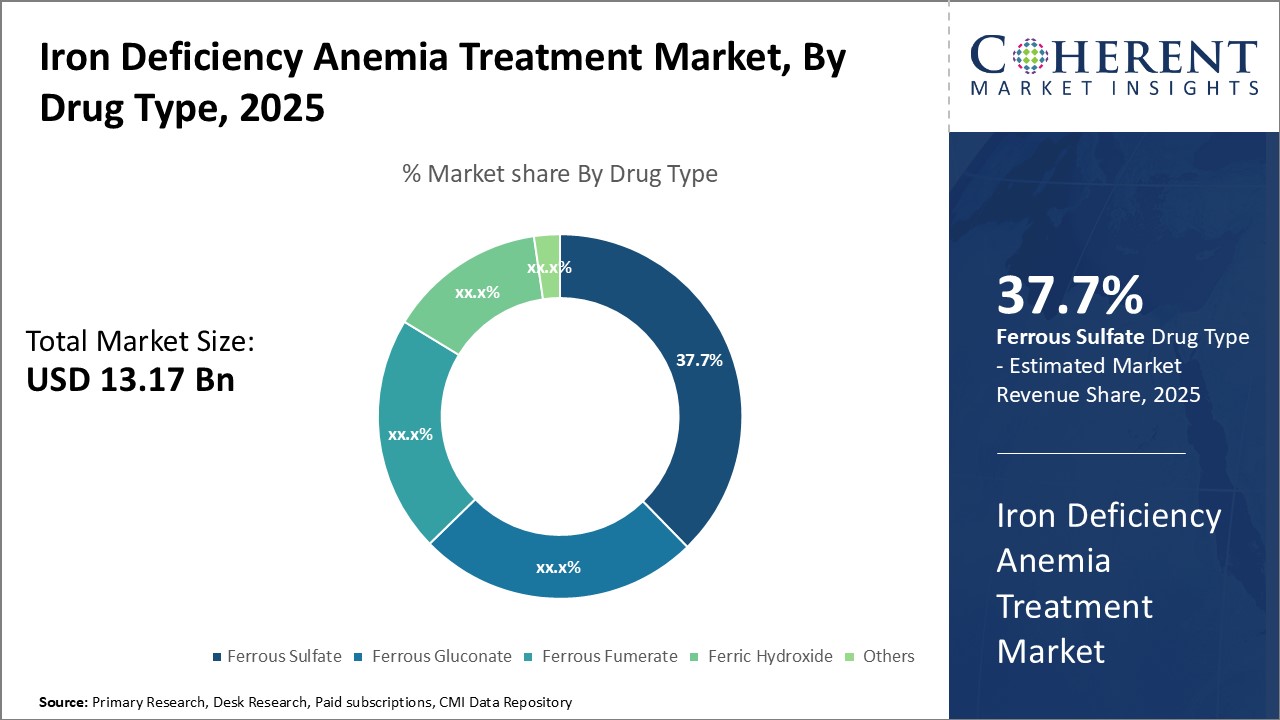
Discover high revenue pocket segments and roadmap to it: Download Free Sample
Insights, By Drug Type: Rising Adoption of Preventive Healthcare ApproachesDrug Type segment is sub-segmented into ferrous sulfate, ferrous gluconate, ferrous fumerate, ferric hydroxide, and others. Ferrous sulfate segment is estimated to hold 37.7% share of the market in 2025 owing to its convenience and compliance advantages over other forms of iron supplementation. Being available in solid oral dosage forms like tablets and capsules, ferrous sulfate is easy for patients to take regularly as part of their daily regimen for treating iron deficiency anemia. Unlike other iron salts that may cause unpleasant side effects like constipation or nausea, ferrous sulfate is generally well-tolerated making patients more compliant in following their prescribed course of treatment.
Insights, By Dosage Form: Tablets Versatility in Dosage and Portability
Dosage Form segment is sub-segmented into tablets, capsules, liquid, and others. Tablets segment is expected to hold 42.6% of the market share in 2025 owing to the flexibility it offers in iron administration. Tablets provide versatility in dosage and portability that make them highly suitable for flexible on-the-go dosing. The main advantage of tablets is their ability to offer a wide range of iron doses from one formulation. This allows physicians to precisely tailor the daily dose to each patient's individual needs and disease severity. This fine-tuning is important to ensure quick and full recovery from anemia without over-administering unnecessary excess iron. Tablets are small, compact and solid oral units that can be popped easily whenever convenient without water. Their portability makes tablets amendable to self-administering an iron supplement on the go between meals or activities. This flexibility supports treatment compliance even for busy lifestyles. Tablets also do not require special administrative devices or follow special storage conditions like some liquid supplements.
Insights, By End User: Convenience and Easy Access for Patients
Distribution channel segment includes hospital pharmacies, retail pharmacies, and online pharmacies. The hospitals segment is expected to hold 50.1% of the market share in 2025 due to convenience and easy access for patients. Many patients suffering from iron deficiency anemia prefer to get the prescriptions filled at the hospital pharmacy itself during or after treatment at the hospital. This is because hospital pharmacies allow for one-stop treatment where patients can obtain consultations, undergo tests, and receive medication for their condition all under one roof. Hospital pharmacies also have patients' medical records and prescription history readily available, allowing pharmacists to offer tailored recommendations and counselling. This helps improve medication adherence. The controlled environment inside hospitals further gives patients a sense of safety and assurance in obtaining treatments for their medical condition. Many hospitals also extend insurance coverage or offer payment plans for discharged patients to continue collecting medications, eliminating the need to visit retail pharmacies separately. The outpatient and inpatient services provided across large hospitals translate to a sizeable pool of patients requiring long-term medication support. As a result, hospital pharmacies witness steady repeat custom that contributes to their dominant position in serving the iron deficiency anemia treatment market. Their strategic location within the premises provides unmatched access and convenience that drives this segment's popularity over others.
Regional Insights
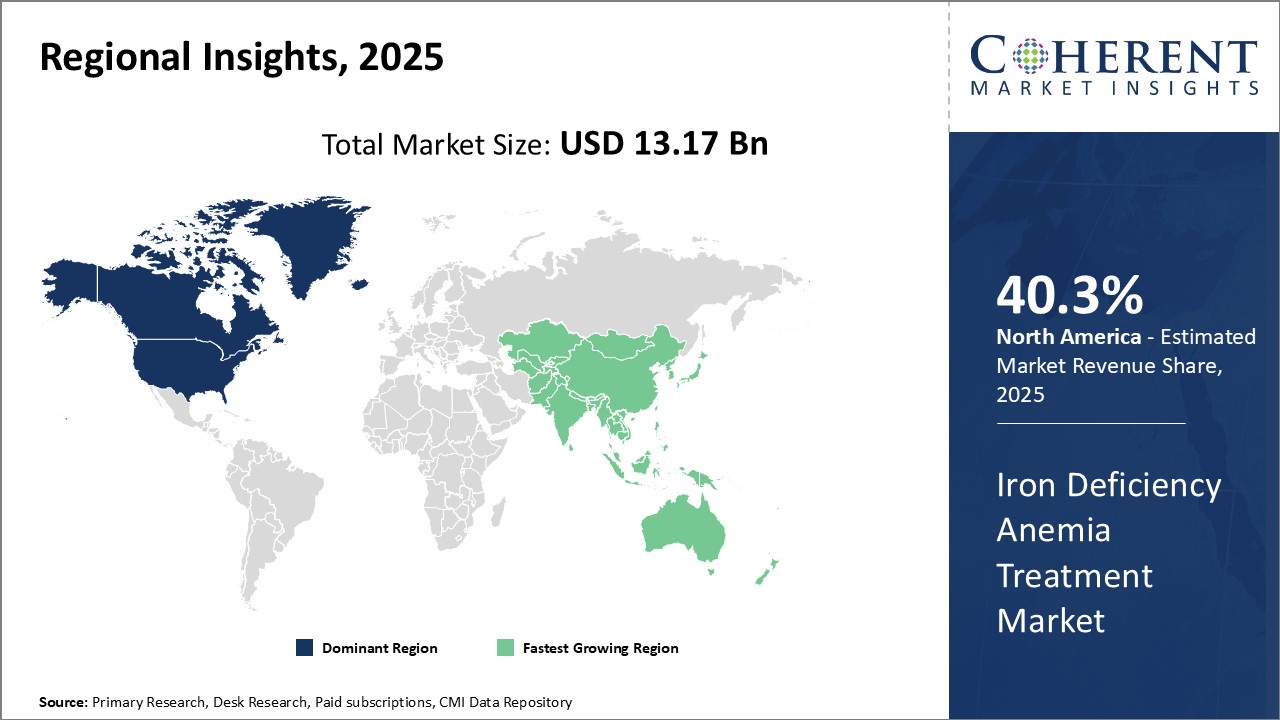
Need a Different Region or Segment? Download Free Sample
North America remains the dominant region in the global iron deficiency anemia treatment Market, and is anticipated to hold 40.3% of the market share in 2025 due to several factors. The U.S. accounts for the bulk of the North American market due to its well-established healthcare infrastructure and high per capita healthcare expenditure. The presence of leading pharmaceutical companies offering a wide range of oral iron supplements and injectable formulations for iron deficiency anemia treatment have made North America the go-to destination for such products. Moreover, factors like better diagnosis and awareness about the condition among both patients and doctors have ensured the early detection and higher treatment-seeking rate for iron deficiency anemia, driving the market size in this region.
The Asia Pacific market is viewed as the fastest growing regional market for iron deficiency anemia treatment. Countries like India and China dominate the Asia Pacific market due to their huge patient pools suffering from iron deficiency anemia, especially among women of reproductive age. Factors such as rising healthcare spending, growing medical tourism, increasing generic drug production, and expanding health insurance coverage in Asia Pacific economies are aiding the market growth in the region. Additionally, iron deficiency anemia is highly prevalent in Asia Pacific due to dietary inadequacies and parasitic infections. This wide diagnosis and treatment gap offers immense untapped market potential for iron deficiency anemia drugs in the region.
Market Report Scope
Iron Deficiency Anemia Treatment Market Report Coverage
| Report Coverage | Details | ||
|---|---|---|---|
| Base Year: | 2024 | Market Size in 2025: | USD 13.17 Bn |
| Historical Data for: | 2020 To 2024 | Forecast Period: | 2025 To 2032 |
| Forecast Period 2025 to 2032 CAGR: | 8.8% | 2032 Value Projection: | USD 23.78 Bn |
| Geographies covered: |
|
||
| Segments covered: |
|
||
| Companies covered: |
AdvaCare Pharma, Otsuka Pharmaceutical Co., Ltd., Sanofi, Emcure Pharmaceuticals, Wellona Pharma, SiNi Pharma Pvt Ltd, Sun Pharmaceutical Industries Ltd., Zydus Group, Akebia Therapeutics., Rockwell Medical, Inc., AbbVie Inc., Pfizer, Inc., Velnex Medicare, PHAEDRUS LIFE SCIENCE PVT. LTD., Inopha International Co, Limited, PharmaNutra S.p.A., Pharmascience Inc., American Regent, Inc. |
||
| Growth Drivers: |
|
||
| Restraints & Challenges: |
|
||
Uncover macros and micros vetted on 75+ parameters: Get instant access to report
Iron Deficiency Anemia Treatment Industry News
- On March 20, 2024, Cadila Pharmaceuticals, a global pharmaceutical company, announced the launch of iron supplement injection, for the treatment of iron deficiency anemia
- In July 2021, Sandoz, a global leader in generic and biosimilar medicines, announced the immediate U.S. availability of generic Ferumoxytol, an intravenous medicine used to treat iron deficiency anemia (IDA)
- In May 2021, American Regent, Inc., a Daiichi Sankyo Group company, announced that the U.S. Food and Drug Administration (FDA) had approved a single 1000 mg dose option of Injectafer (ferric carboxymaltose injection), an iron replacement product, for the treatment of iron deficiency anemia (IDA) in adult patients who have intolerance to oral iron, have had unsatisfactory response to oral iron, or have non-dialysis dependent chronic kidney disease (CKD)
- In May 2020, Akebia Therapeutics., a pharmaceutical company, in collaboration with Japan Tobacco, Inc., a Japan-based tobacco company, filed a supplemental New Drug Application (NDA) with the Pharmaceuticals and Medical Devices Agency (PMDA) seeking an additional indication for Riona Tablets 250mg (generic name in Japan: ferric citrate hydrate) to treat adult patients with iron deficiency anemia (IDA) in Japan
*Definition: Iron deficiency anemia treatment market consists of pharmaceutical products that help treat iron deficiency anemia by supplementing the body with iron. This includes oral iron supplements like ferrous sulfate and ferrous gluconate that are taken daily to replenish iron stores. Intravenous iron formulations are also available for patients who cannot tolerate oral supplements or have more severe anemia. The goal of treatment is to increase hemoglobin levels and resolve symptoms of anemia like fatigue, weakness, and shortness of breath.
Market Segmentation
- Drug Type Insights (Revenue, US$ Bn, 2020 - 2032)
- Ferrous Sulfate
- Ferrous Gluconate
- Ferrous Fumerate
- Ferric Hydroxide
- Others
- Dosage Form Insights (Revenue, US$ Bn, 2020 - 2032)
- Tablets
- Capsules
- Liquid
- Others
- Distribution Channel Insights (Revenue, US$ Bn, 2020 - 2032)
- Hospital Pharmacies
- Retail Pharmacies
- Online Pharmacies
- Regional Insights (Revenue, US$ Bn, 2020 - 2032)
- North America
- U.S.
- Canada
- Latin America
- Brazil
- Argentina
- Mexico
- Rest of Latin America
- Europe
- Germany
- U.K.
- Spain
- France
- Italy
- Russia
- Rest of Europe
- Asia Pacific
- China
- India
- Japan
- Australia
- South Korea
- ASEAN
- Rest of Asia Pacific
- Middle East
- GCC Countries
- Israel
- Rest of Middle East
- Africa
- South Africa
- North Africa
- Central Africa
- North America
- Key Players Insights
- AdvaCare Pharma
- Otsuka Pharmaceutical Co., Ltd.
- Sanofi
- Emcure Pharmaceuticals
- Wellona Pharma
- SiNi Pharma Pvt Ltd
- Sun Pharmaceutical Industries Ltd.
- Zydus Group
- Akebia Therapeutics.
- Rockwell Medical, Inc.
- AbbVie Inc.
- Pfizer, Inc.
- Velnex Medicare
- PHAEDRUS LIFE SCIENCE PVT. LTD.
- Inopha International Co, Limited
- PharmaNutra S.p.A.
- Pharmascience Inc.
- American Regent, Inc.
Share
Share
About Author
Ghanshyam Shrivastava - With over 20 years of experience in the management consulting and research, Ghanshyam Shrivastava serves as a Principal Consultant, bringing extensive expertise in biologics and biosimilars. His primary expertise lies in areas such as market entry and expansion strategy, competitive intelligence, and strategic transformation across diversified portfolio of various drugs used for different therapeutic category and APIs. He excels at identifying key challenges faced by clients and providing robust solutions to enhance their strategic decision-making capabilities. His comprehensive understanding of the market ensures valuable contributions to research reports and business decisions.
Ghanshyam is a sought-after speaker at industry conferences and contributes to various publications on pharma industry.
Missing comfort of reading report in your local language? Find your preferred language :
Transform your Strategy with Exclusive Trending Reports :
Frequently Asked Questions
EXISTING CLIENTELE
Joining thousands of companies around the world committed to making the Excellent Business Solutions.
View All Our Clients
